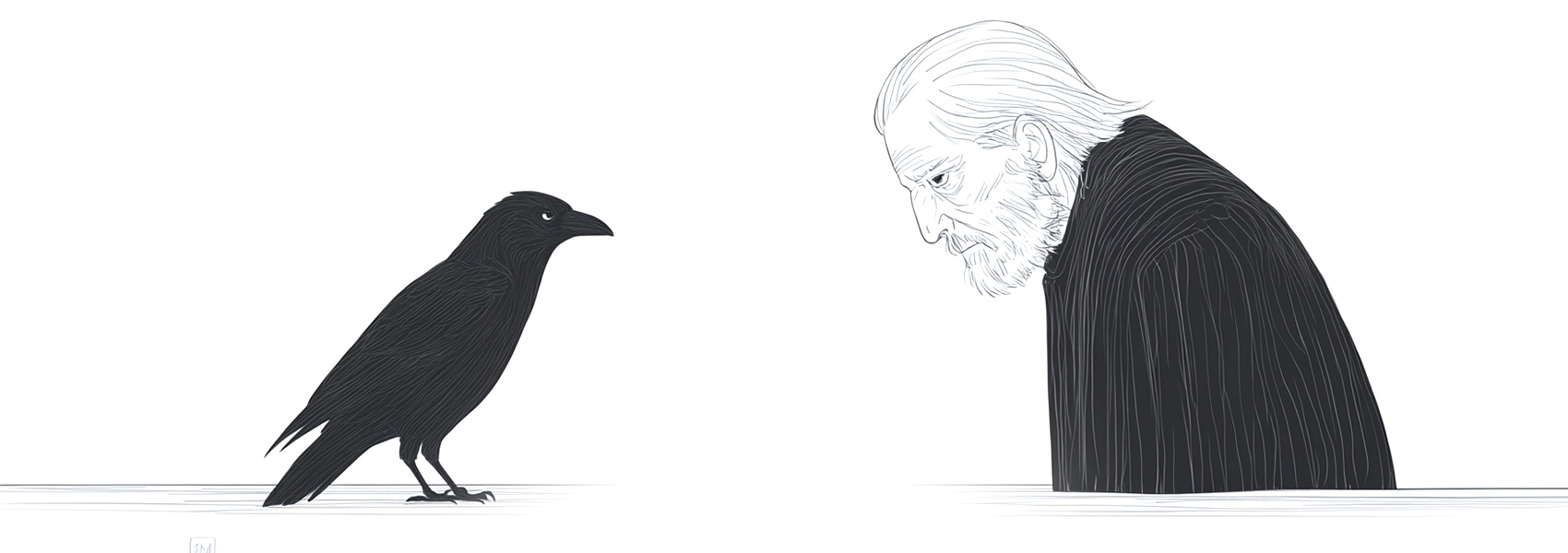
Edgar Allan Poe’s The Raven (1845) is a cornerstone of American Gothic literature, a haunting narrative poem that delves into the depths of sorrow, obsession, and the human psyche’s unraveling. With its hypnotic rhythm, chilling imagery, and iconic refrain of “Nevermore,” The Raven has captivated readers for generations, cementing Poe’s legacy as a master of macabre storytelling. This SEO-optimized summary unpacks the poem’s plot, symbolism, and themes while exploring its enduring relevance in discussions of mental health, existential despair, and the art of poetic form.
The poem opens on a “dreary” December night, where an unnamed narrator, bereaved and isolated, pores over forgotten books in a dimly lit chamber. He mourns the loss of Lenore, a beloved woman whose death has left him trapped in a cycle of grief. As he nods off, a tapping disturbs the silence—first at his chamber door, then at his window.
The narrator opens the window to find a statuesque raven, which perches atop a bust of Pallas Athena (the Greek goddess of wisdom). The bird’s stern demeanor and jet-black feathers contrast starkly with the pallid bust, symbolizing the clash between reason and irrational despair. The narrator, half-amused, asks the raven’s name, to which it replies, “Nevermore.”
The narrator, increasingly agitated, poses questions to the raven, each met with the same chilling answer: “Nevermore.” He inquires whether he’ll reunite with Lenore in the afterlife, whether there’s balm for his anguish, and if the raven is a divine or demonic messenger. The bird’s relentless refrain amplifies the narrator’s torment, stripping away his hope and anchoring him in perpetual mourning.
In the poem’s climax, the narrator commands the raven to leave, but it remains immovable, casting a shadow over his soul. The final stanza reveals the narrator’s eternal imprisonment in grief: “And my soul from out that shadow that lies floating on the floor / Shall be lifted—nevermore!”
The raven embodies the narrator’s inability to escape loss. Its repetitive “Nevermore” mirrors the cyclical nature of mourning, where memories of Lenore resurface relentlessly. Poe suggests that grief, once internalized, becomes a permanent tenant of the psyche.
Key Quote: “Till the dirges of his Hope that melancholy burden bore / Of ‘Never—nevermore.’”
The narrator’s interrogation of the raven reveals a subconscious desire for punishment. By asking questions he knows will elicit “Nevermore,” he willingly subjects himself to despair, illustrating humanity’s propensity to dwell in pain.
The bust of Pallas Athena symbolizes rationality and wisdom, while the raven represents irrationality and primal emotion. Their juxtaposition underscores the narrator’s internal battle—his logical mind knows Lenore is gone, yet his heart clings to denial.
“Nevermore” serves as a brutal reminder of death’s irrevocability. The raven’s refusal to leave parallels the permanence of loss, rejecting the narrator’s yearning for closure or reunion.
Poe employs trochaic octameter, a meter with eight stressed-unstressed syllables per line, creating a dirge-like cadence. The poem’s ABCBBB rhyme scheme and internal rhymes (e.g., “rapping, tapping”) amplify its hypnotic, oppressive mood.
Phrases like “weak and weary” and “silken, sad, uncertain” use alliteration to mirror the narrator’s spiraling thoughts. The refrain “Nevermore” acts as a psychological hammer, breaking down the narrator’s resolve.
Poe’s vivid descriptions—the “midnight dreary,” the “silken purple curtain”—evoke a claustrophobic, dreamlike atmosphere. The raven’s “fiery eyes” and shadow symbolize the inescapable presence of sorrow.
Written during a period of profound personal loss (Poe’s wife, Virginia, was dying of tuberculosis), The Raven channels the author’s anguish into art. Published in 1845, it became an instant sensation, though Poe earned little profit. The poem’s exploration of psychological torment resonated in an era grappling with Romanticism’s emotional intensity and the rise of existential inquiry.
Modern critics view the raven as a manifestation of the narrator’s depression or PTSD, reflecting contemporary understandings of mental health. The poem’s depiction of obsessive rumination aligns with studies on grief pathology.
In today’s world of fleeting digital interactions and unresolved collective traumas, The Raven speaks to the universal experience of clinging to loss. Its themes resonate in discussions of:
The Raven is more than a Gothic relic—it is a mirror to the darkest corners of the human soul. Poe’s genius lies in transforming personal agony into universal art, reminding us that grief, like the raven, perches eternally in the chambers of the heart. Its final lines, steeped in desolation, challenge readers to confront their own shadows and ask: What lingering sorrows whisper “Nevermore” in our lives?
By weaving lyrical analysis with cultural context, this summary illuminates why The Raven remains a masterpiece of melancholy—a midnight lament that continues to echo through the ages.
